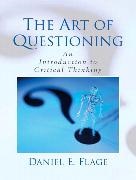Ulteriori informazioni
Dan Flage provides a comprehensive and systematic approach to critical thinking in his text The Art of Questioning. It begins with simple issues at the level of words and concludes with large-scale applications, applying all the skills discussed in this book to reading and writing essays. Throughout, there is a commitment to intellectual rigor and student-friendliness. Each topic begins with relatively simple and straightforward cases and moves systematically to the kinds of messy cases found in ordinary language.
Features of The Art Of Questioning:
- Contains over 1,200 exercises and discussion questions drawn from diverse sources and covering numerous distinct topics
- Draws examples and exercises from a wide range of fields- both timeless classic and contemporary issues, such as the events of September 11.
- Includes solutions to the odd-numbered exercises, which gives students immediate feedback on their work.
- Contains unique chapters on evaluation of essays (Chapter 32) and writing argumentative essays (Chapter 33) that pull together all the individual skills honed in the earlier chapters.
Sommario
(NOTE: Each section begins with an Introduction.)I. SOME USES OF LANGUAGE.
1. The Informative Function of Language.
2. The Directive Function of Language.
3. The Emotive Function of Language.
4. Descriptive Passages.
5. Explanations.
II. ARGUMENTS.
6. Deduction.
7. Induction.
8. Recognizing Arguments.
9. Tree Diagrams for Arguments.
III. CHECKING THE EVIDENCE.
10. Observations: When Should Seeing Be Believing?
11. Testimony: Whom Do You Trust?
12. Values and Obligations: What Should You Do?
IV. CATEGORICAL SYLLOGISMS.
13. Categorical Propositions.
14. Categorical Syllogisms.
15. Rules for Judging Validity.
16. Venn Diagrams for Judging Validity.
17. Missing Premises and Conclusions.
18. Conversion, Obversion, and Squares of Opposition.
19. Living in the “Real World.”
V. PROPOSITIONAL ARGUMENTS.
20. Simple and Compound Statements.
21. Truth Tables.
22. Common Propositional Argument Forms.
23. Enthymemes, Argument Chains, and Other Hazards.
24. Some Logical Equivalences.
VI. INDUCTIVE ARGUMENTS.
25. Analogies.
26. Generalizations and Surveys.
27. Hypotheses, Explanations, and Argument to the Best Explanation.
VII. INFORMAL FALLACIES.
28. Fallacies of Ambiguity.
29. Fallacies of Relevance.
30. Fallacies of Presumption.
31. Fallacies of Weak Induction.
VIII. LARGE-SCALE APPLICATIONS.
32. How to Read an Essay.
33. How to Write an Argumentative Essay.
Solutions to the Odd Numbered Problems.
Glossary.
Index.
Riassunto
For undergraduate level courses in Critical Thinking, and Writing courses.
This text offers students the clearest explanations and the most examples of any critical thinking text on the market. Begins with issues concerning words, examines techniques for evaluating explanations and arguments, and concludes by applying all the skills to reading essays and writing argumentative essays.

